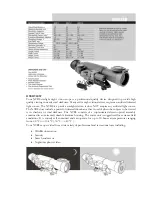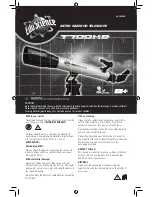
5
Visit us at:
nationalgeographic.com
Telescope Terms To Know:
Diagonal: A mirror that deflects the ray of light 90 degrees.
With a horizontal telescope tube, this device deflects the light upwards so
that you can comfortably observe by looking downwards into the eyepiece.
The image in a diagonal mirror appears upright, but rotated around its
vertical axis (mirror image).
Focal length: Everything that magnifies an object via an optic lens has a certain focal length. The focal length is the
length of the path the light travels from the surface of the lens to its focal point. The focal point is also referred to as the
focus. In focus, the image is clear. In the case of a telescope, the focal length of the telescope tube and the eyepieces
are used to determine magnification.
Lens: The lens turns the light that falls on it around in such a way so that the light gives a clear image in the focal point
after it has traveled a certain distance (focal length).
Part I: Assembly
Before you begin assembly, choose a suitable location for your telescope. It is best to build the telescope in a place
where you have a clear view of the skies, a stable footing and sufficient space around you. Remove all the parts from
the packaging, and, using the diagram, check to make sure no parts are missing.
1. Tripod
Take the tripod (9) out of the box. Carefully open the legs and place the tripod on a level surface.
To secure the legs, place the accessory tray (12) in the center of the leg supports and rotate it until it locks into
position (No. 3).
Note: Please do not forget to remove the accessory tray before collapsing the tripod.
2. Telescope
Loosen the screw (12) in the dovetail mount so that it is completely retract-ed (No. 4). Place the telescope with the
dovetail in the mount and tighten the screw. Make sure that the National Geographic logo is upright.
3. Altitude knob
Loosen the vertical knob by rotating it anticlockwise, align the optical telescope tube (1) horizontally and re-tighten
the knob (No. 5).
4. Mount
Place the mount base’s mounting holes on the tripod’s mounting screws and tighten them (No. 6).
5. Dust cover
Remove the dust cover (14) that protects the objective lens of the optical tube opening (2).
6. Eyepiece
Remove one eyepiece from its eyepiece holder (6) and slide it into the eyepiece connection (3). Tighten the holding
screws (No. 5). Start with the lowest magnification eyepiece, which has the highest focal length printed on it (e.g. 20
mm or 25 mm, depending on your model) to locate objects and find the correct focus. If you have the object you want
to view centered in the field of view, switch to a higher magnification by using an eyepiece with shorter focal length.
After changing the eyepiece, it might be necessary to adjust the focus again (see section 8).
7. Focus wheel
To get objects into focus, your telescope is equipped with a precise focus control. When you use the telescope for the
first time, you might need to turn the focus wheel (4) multiple times to achieve a focused image. To try it out, pick a
landmark or a building far away in daylight or bright twilight, and turn the focus wheel until the object comes into
focus. Remember, objects to be observed cannot be closer than 20 meters away.
















